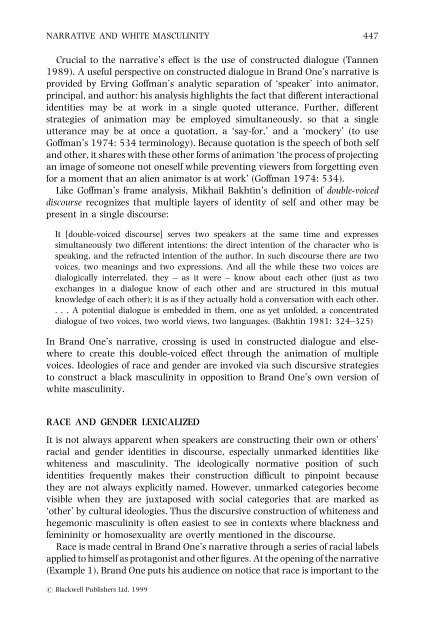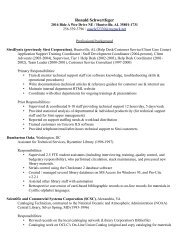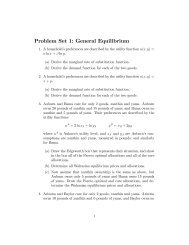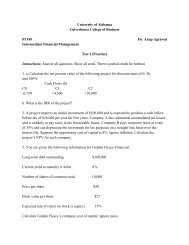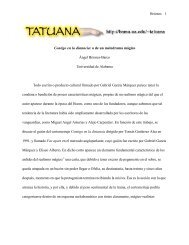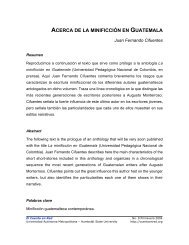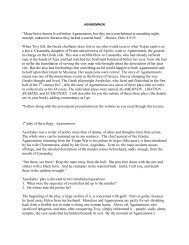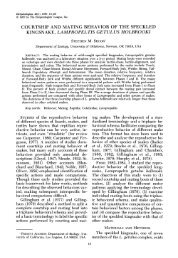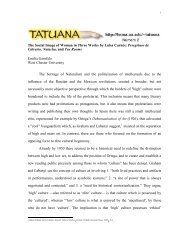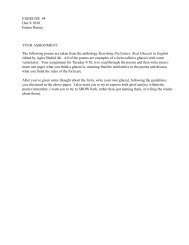You da man: Narrating the racial other in the ... - Bama.Ua.Edu
You da man: Narrating the racial other in the ... - Bama.Ua.Edu
You da man: Narrating the racial other in the ... - Bama.Ua.Edu
Create successful ePaper yourself
Turn your PDF publications into a flip-book with our unique Google optimized e-Paper software.
NARRATIVE AND WHITE MASCULINITY 447<br />
Crucial to <strong>the</strong> narrative's e€ect is <strong>the</strong> use of constructed dialogue (Tannen<br />
1989). A useful perspective on constructed dialogue <strong>in</strong> Brand One's narrative is<br />
provided by Erv<strong>in</strong>g Go€<strong>man</strong>'s analytic separation of `speaker' <strong>in</strong>to animator,<br />
pr<strong>in</strong>cipal, and author: his analysis highlights <strong>the</strong> fact that di€erent <strong>in</strong>teractional<br />
identities may be at work <strong>in</strong> a s<strong>in</strong>gle quoted utterance. Fur<strong>the</strong>r, di€erent<br />
strategies of animation may be employed simultaneously, so that a s<strong>in</strong>gle<br />
utterance may be at once a quotation, a `say-for,' and a `mockery' (to use<br />
Go€<strong>man</strong>'s 1974: 534 term<strong>in</strong>ology). Because quotation is <strong>the</strong> speech of both self<br />
and o<strong>the</strong>r, it shares with <strong>the</strong>se o<strong>the</strong>r forms of animation `<strong>the</strong> process of project<strong>in</strong>g<br />
an image of someone not oneself while prevent<strong>in</strong>g viewers from forgett<strong>in</strong>g even<br />
for a moment that an alien animator is at work' (Go€<strong>man</strong> 1974: 534).<br />
Like Go€<strong>man</strong>'s frame analysis, Mikhail Bakht<strong>in</strong>'s de®nition of double-voiced<br />
discourse recognizes that multiple layers of identity of self and o<strong>the</strong>r may be<br />
present <strong>in</strong> a s<strong>in</strong>gle discourse:<br />
It [double-voiced discourse] serves two speakers at <strong>the</strong> same time and expresses<br />
simultaneously two di€erent <strong>in</strong>tentions: <strong>the</strong> direct <strong>in</strong>tention of <strong>the</strong> character who is<br />
speak<strong>in</strong>g, and <strong>the</strong> refracted <strong>in</strong>tention of <strong>the</strong> author. In such discourse <strong>the</strong>re are two<br />
voices, two mean<strong>in</strong>gs and two expressions. And all <strong>the</strong> while <strong>the</strong>se two voices are<br />
dialogically <strong>in</strong>terrelated, <strong>the</strong>y ± as it were ± know about each o<strong>the</strong>r (just as two<br />
exchanges <strong>in</strong> a dialogue know of each o<strong>the</strong>r and are structured <strong>in</strong> this mutual<br />
knowledge of each o<strong>the</strong>r); it is as if <strong>the</strong>y actually hold a conversation with each o<strong>the</strong>r.<br />
. . . A potential dialogue is embedded <strong>in</strong> <strong>the</strong>m, one as yet unfolded, a concentrated<br />
dialogue of two voices, two world views, two languages. (Bakht<strong>in</strong> 1981: 324±325)<br />
In Brand One's narrative, cross<strong>in</strong>g is used <strong>in</strong> constructed dialogue and elsewhere<br />
to create this double-voiced e€ect through <strong>the</strong> animation of multiple<br />
voices. Ideologies of race and gender are <strong>in</strong>voked via such discursive strategies<br />
to construct a black mascul<strong>in</strong>ity <strong>in</strong> opposition to Brand One's own version of<br />
white mascul<strong>in</strong>ity.<br />
RACE AND GENDER LEXICALIZED<br />
It is not always apparent when speakers are construct<strong>in</strong>g <strong>the</strong>ir own or o<strong>the</strong>rs'<br />
<strong>racial</strong> and gender identities <strong>in</strong> discourse, especially unmarked identities like<br />
whiteness and mascul<strong>in</strong>ity. The ideologically normative position of such<br />
identities frequently makes <strong>the</strong>ir construction di cult to p<strong>in</strong>po<strong>in</strong>t because<br />
<strong>the</strong>y are not always explicitly named. However, unmarked categories become<br />
visible when <strong>the</strong>y are juxtaposed with social categories that are marked as<br />
`o<strong>the</strong>r' by cultural ideologies. Thus <strong>the</strong> discursive construction of whiteness and<br />
hegemonic mascul<strong>in</strong>ity is often easiest to see <strong>in</strong> contexts where blackness and<br />
fem<strong>in</strong><strong>in</strong>ity or homosexuality are overtly mentioned <strong>in</strong> <strong>the</strong> discourse.<br />
Race is made central <strong>in</strong> Brand One's narrative through a series of <strong>racial</strong> labels<br />
applied to himself as protagonist and o<strong>the</strong>r ®gures. At <strong>the</strong> open<strong>in</strong>g of <strong>the</strong> narrative<br />
(Example 1), Brand One puts his audience on notice that race is important to <strong>the</strong><br />
# Blackwell Publishers Ltd. 1999


